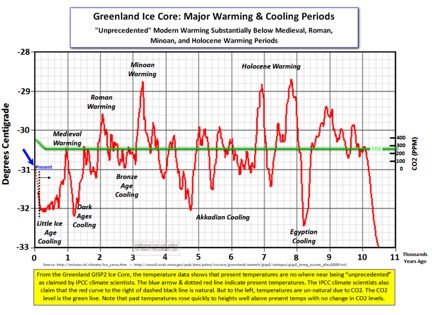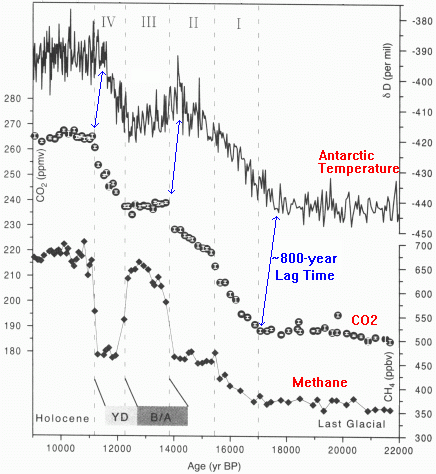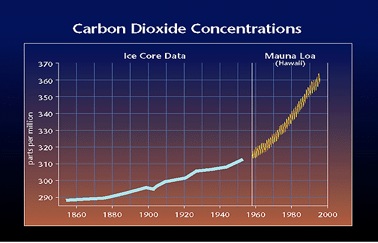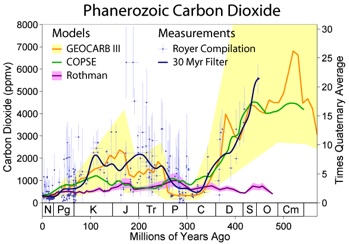For the past 1.3 million years there have been 13 ice ages, average duration 90,000 years, and each followed by an interglacial period, average duration 10,000 years. During both ice ages and interglacial periods, there will be numerous briefer cycles of warming and cooling. A 65 million year review of climate and related information is available at
JoNova.
If this one million+ year trend continues, we are now nearing the end of our current interglacial period. The actual duration will likely vary somewhat from the 10,000 year average. Even assuming that the ice age cycle again repeats, its start date will probably not be easy to recognize in real-time.
During our current interglacial period there have been several periods when it was warmer than now. The most recent prior warming, and hence best documented, was about 1,000 years ago, spanning the period from about 800 to 1300 AD, and is referred to as the Medieval Warming Period (MWP).

© Unknown
Ancient vineyards dating to the MWP have been found in northern areas in England where even today grapes cannot be grown. The Vikings took up residence during the MWP on "Greenland" (and named it). They were able to map the entire coast line of Greenland because it was at that time free of ice. The most recent cooling period during our current interglacial was from about 1200 to 1700 AD, and known as "the little ice age". This cooling period began about the same time that the Vikings began leaving Greenland. As can be seen from the websites below, scientists have established that the MWP was global and not just a regional phenomenon.
http://pages.science-skeptical.de/MWP/MedievalWarmPeriod1024×768.htm
http://www.c3headlines.com/climate-history/So, if temperatures on several occasions during our current interglacial period have been higher than now, why this concern about global warming?There has been a strong historical correlation between the rising levels of carbon dioxide (CO2) and temperature for the past 600,000 years. Over that entire period the ceiling on CO2 remained at or below 280ppmv (parts per million by volume in the atmosphere). At the time our industrial revolution began, about two centuries ago, CO2 broke through that ceiling and continued to rise. It has now reached about 390 ppmv. Temperature has also begun to increase about the same time, so the preliminary interpretation of the CO2/temperature correlation was that industrial activities are contributing to the rise in CO2 and therefore CO2 must be responsible for this warming.
However, subsequent examination of core samples, where both CO2 and temperature were taken from the same sample, showed that there was about an 800 year lag between the rise in temperature and the later rise in CO2. It was temperature that increased first! That should have put the scientists on notice that there were problems with the anthropogenic global warming (AGW) theory. The following graph is courtesy of
John-Daly.com.

© John Daly.com
The AGW advocates instead refocused on the past couple of centuries, where both CO2 and the temperature were increasing and continued assuming that CO2 was driving temperature. However, that assumption was also blown out of the water again because during the past two decades, as CO2 continued its steady increase, temperature remained basically flat.
The computer models simulating climate change failed because of the built-in assumption that CO2 was driving temperature. Computer model predictions are not "evidence." It is not unusual for a model to successfully predict past periods. Computer models never get out of the testing stage until they have been sufficiently reworked to match historical data. Arguing that the models are reliable because they perfectly reflect historical activity would be ludicrous. Not only that, attempting to predict results 100 years into the future by simulating both a very complex and poorly understood climate along with the impact on it due to changing world economics is a guaranteed exercise in futility.
The warming over the past two centuries is well within the bounds of natural variation and is to be expected after several hundred years of cooling by the "little ice age." The fact that temperatures during the MWP (and during several earlier warming periods) were also higher than our current temperatures, put the final nail in the AGW coffin. A good review of the process (the "scientific method") for confirming or rejecting theories appears in
The Resilient Earth below.
But, what about carbon dioxide? It is now well above the long established ceiling of 280ppm.In the more distant past (around 100 million years and beyond, and keeping in mind that the earth is 4 billion years old) carbon dioxide levels were almost always much higher. We know that higher levels of CO2 are great for plant life, and there is no evidence that these higher levels had any harmful effect on animal life. The CO2 level has also been much higher during three ice ages. In fact, CO2 was much higher going into one ice age, so it does not appear to have much impact, either directly or via feedback on temperature. We also know that further increase will hardly contribute to its feedback. There is already enough CO2 in the atmosphere to entirely absorb the few wavelengths of available infrared.
The only other known link between human activity and temperature is the Urban Heat Island (UHI) effect, but UHI appears to be a local phenomenon. Temperature readings in surrounding rural areas do not pick up any of that heat, and since urban areas constitute a very small percentage of the total surface area it has no impact on the global temperature.
Carbon dioxide represents less than 4/100 of one percent of the atmosphere. It is currently at about 390ppmv of the atmosphere. Water vapor, also a greenhouse gas, varies more, but generally comprises 1% to 4% of the atmosphere, so is approximately 50 times more prevalent than CO2. In recent years the annual increase in CO2 has been about 2ppmv. While Methane is 20 times as potent as CO2, as a greenhouse gas, it represents only 1/200 of CO2 volume

© Unknown

© Unknown
The level of carbon dioxide is increasing quite slowly, so drastic revisions in economic policy are not warranted. There appears to be time for us to convert to natural gas and nuclear power, although US action will have little or no effect unless other populous countries such as China and India, do the same.
Reference:
Skeptical ScienceWhat about all these other related concerns: rising sea levels, melting ice and receding glaciers, more violent earthquakes, hurricanes, droughts, suicides, you-name-it?Some of those issues may indeed be influenced by global warming, but there is no evidence that human activities are responsible for global warming, so this is part of the ongoing natural process. You don't have to like it, but you do have to live with it.
After all, we are apparently (and thank goodness) still in our interglacial period, so melting ice and sea level rise (where this may actually be happening) should not be surprising. You'll know a real problem is coming up when there are no longer any receding glaciers, and there is no melting ice.
Since the ice age durations were different a couple of million years ago, what else could be influencing climate change?We all know about the four seasons of climate variation brought on by the earth's annual revolution around the sun. There are also other related, but more subtle influences on climate change that involve much longer cycles. These are related to the earth's "tilt" and associated wobbles relative to its orbital plane and to the eccentricity of its orbit. The former involves a 42,000 year cycle and the latter a 100,000 year cycle. For more detail see, for example,
this article.
A more recent theory on climate indicates that we must also take into consideration our position in the Milky Way. One revolution around the Galaxy takes about 250 million years. Keep in mind that the earth has experienced quite a few ice ages in just this past one million years.
About two decades ago Svensmark and several associates, representing various scientific disciplines (physics, astronomy, geology, and oceanography), came up with a theory that may explain a significant part of climate change. This theory involves sunspot activity, and its interaction with cosmic rays, their influence on the amount of low cloud cover, and our location in the Galaxy.
The theory is backed by strong correlations across hundreds of millions of years of historic data and is also confirmed by current data. They have also shown through experiment that aerosol buildup by the more energetic cosmic rays is possible. Svensmark, in 1995, predicted an approaching cooling period when everyone else was still concerned about global warming. (As a consequence he was obviously not very popular with the AGW folks.)
Cosmic Rays that penetrate the earth's atmosphere and have sufficient energy to impact the lower atmosphere create aerosols which contribute to cloud cover buildup. Increased cloud cover leads to cooling. Less cloud cover leads to warming. Low clouds typically cover about 60% to 65% of the earth's surface. Cosmic rays emanate from exploding stars. The number of exploding stars, together with their proximity, the energy level of the cosmic rays, and the level of solar activity dictate the results.
When the sun is in an active period, fewer cosmic rays are able to overcome the solar wind, so do not even reach the earth's atmosphere. During such periods there is less cloud cover and hence warming, and it is the reverse during periods of solar inactivity. .
When the solar system is in or near one of the spiral arms of our Galaxy there are likely to be more stars in the vicinity, hence likely to be more exploding stars and therefore more cosmic rays.
The first website below is a 6 part video with more detail, in an easily understood and enjoyable presentation. Except for about the first minute of the first part, there are English subtitles but thereafter the audio is in English. The second website is a CERN colloquium held by Jasper Kirkby for physicists, much of it related to the same climate data relevant to Svensmark.
(Svensmark, 6 part youtube)
(CERN Colloquium)Some reference books:
"
The Resilient Earth" (Doug L. Hoffman and Allen Simmons)
"
The Chilling Stars: A Cosmic View of Climate Change" (Henrik Svensmark & Nigel Calder
Some (there are many others!) websites:
Warren Meyer, Climate-Skeptic.comJohn Costella, "Analysis of ClimateGate"Anthony WattsMarc Moranohttp://scienceandpublicpolicy.org/
Reader Comments
to our Newsletter